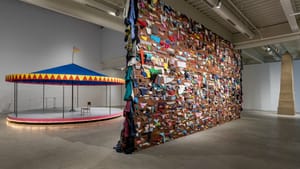Stay in the Loop
BSR publishes on a weekly schedule, with an email newsletter every Wednesday and Thursday morning. There’s no paywall, and subscribing is always free.
Moving monuments
ICA presents Karyn Olivier’s ‘Everything That’s Alive Moves’

One of the things that modern art does so well is social commentary. Karyn Olivier’s current solo exhibition at the University of Pennsylvania’s Institute for Contemporary Art (ICA), Everything That’s Alive Moves, certainly bears out that truth.
“Everything” consists of a series of large-scale sculptures which, according to ICA, examine monuments’ relation to civic space, how monuments reveal “what it means to be a citizen,” and how we can make these edifices “humble and audacious in equal measure.”
Building walls
Many of the pieces force the viewer to ponder issues of citizenship and individual responsibility.
Fortified is a huge wall, constructed of bricks and used clothes. Of course, the meaning you derive from such a piece depends entirely on the personal biases through which you view it. Does the wall represent a fortress in which we can seek protection from a hostile outside world—or does it represent a prison meant to protect the world from us? And the clothes—do they represent how much personal responsibility we must shoulder for the construction of such barriers? The piece offers no easy answers.
The merry-go-round
Other pieces shift our focus to the familiar cast in an unfamiliar light, forcing us to ponder old certainties in new uncertain ways.
2004’s It’s Not Over ’Til It’s Over is one of the earliest pieces in the exhibit. It is essentially a one-person carousel. Is this representative of the merry-go-round of life that we as individuals must ride alone? Are we stuck on that merry-go-round? I think the answer to that question can be found in the piece’s title.
Looking back, looking forward
One of the newest pieces in the exhibit, The Obelisk, probably reflects Olivier’s year of study in Rome, investigating the ancient city’s ruins, histories, and public works. This plugs into her recent thinking, which has been centered on civic space, specifically monuments and memorials.
The Obelisk, perhaps the most traditionally monumental item in the exhibit, towers over everything else in the gallery. Obelisks tend to be representative of ancient history, of vanished civilizations that long pre-date the one we live in. But the presence of such a reminder of history in today’s civic spaces might also make us more aware of the history that’s unfolding even as we live our lives, and how we in our turn will also be an ancient, long-gone civilization with much in common with our forbears.
As with all the best modern art leaning toward social commentary, Olivier’s sculptures ask difficult questions, avoid easy answers, and force viewers to ponder outside their comfort zone.
What, When, Where
Everything That’s Alive Moves. By Karyn Olivier. Through May 10, 2020, at the Institute for Contemporary Art, 118 S. 36th St., Philadelphia. (215) 898-7108 or icaphila.org.
ICA is a wheelchair-accessible venue. Visit online for more accessibility info. All ICA programs are free and open to the public.
Sign up for our newsletter
All of the week's new articles, all in one place. Sign up for the free weekly BSR newsletters, and don't miss a conversation.

 Gary L. Day
Gary L. Day